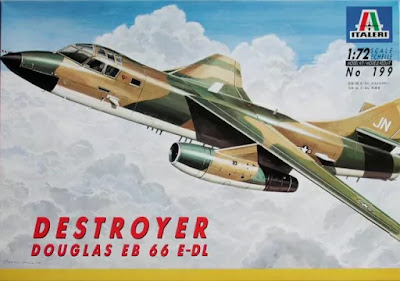The Douglas B-66 Destroyer was a United States Air Force light bomber based on the U.S. Navy's A-3 Skywarrior carrier-based heavy attack aircraft. The B-66 was intended to replace the Douglas A-26 Invader, and an RB-66 photo-reconnaissance version was ordered simultaneously. The USAF B-66 retained the three-man crew from the US Navy A-3, but incorporated ejection seats that the US Navy variant lacked.
At first, the United States Air Force intended the conversion to be an easy matter of removing the carrier-specific features, so no prototypes were ordered, just five pre-production RB-66A models (the reconnaissance mission being considered a high priority). The list of modifications grew, and before long, the supposedly easy conversion became what was substantially a new aircraft.
--------------------------------------
Douglas B-66 Destroyer on suihkumoottorikäyttöinen taktinen eli kevyt tai keskiraskas pommikone. Tyyppi oli Yhdysvaltain ilmavoimien vastine laivaston Douglas A-3 Skywarrior -koneelle. B-66 Destroyerissa ei ollut tukialusvarusteita, kuten esimerkiksi jarrukoukkua tai taitettavia siipiä.
Konetyyppi vakuutti ensi alkuun ilmavoimien edustajat suorituskyvyllään, mutta Sharpen mukaan koneen huoltotarve vaikutti palvelusiän elinkaareen, joka jäi melko lyhyeksi. Huoltotoimet olivat osoittautuneet kalliiksi ja hankaliksi.
B-66 Destroyerin huippunopeus oli A-3 Skywarrioria suurempi:1 020 km/h.
Kone oli 60 senttimetriä pidempi, 3 senttimetriä korkeampi ja sen siipien pinta-ala oli noin 3 neliömetriä pienempi kuin A-3:ssa.
B-66 Destroyerin tyhjäpaino oli lähes 2 000 kg ja enimmäislentoonlähtöpaino noin 455 kg verrokkiaan suurempi.
Osa tyypin koneista sai merkinnän EB-66 tai RB-66, jotka viittasivat lentotiedusteluun sekä häirintätehtäviin.
5 443 kg pommikuorman kuljettamaan kyennyt kone pystyi myös taktisiin ydinpommituksiin.
Konetyyppi osallistui Vietnamin sotaan, ja se vedettiin pois palveluskäytöstä vuonna 1973.
-------------------------------------
Many of the changes were due to the USAF's requirement for low-level operations, while the Navy version had originally been designed and employed as a high-altitude nuclear strike bomber.
Two major differences between the A-3 and the B-66 consisted in the types of jet engines used, and the emergency crew egress systems.
The A-3 had two J57 turbojet engines, whereas the B-66 had two Allison J71s.
The B-66 was was equipped with ejection seats where as the A-3not.
The first RB-66A pre-production aircraft flew in 1954, whereas the first production RB-66B aircraft flew in the beginning of 1955.
----------------------------
General characteristics
Crew: 3, Pilot, Navigator and EWO
Length: 22.9 m
Wingspan: 22.1 m
Height: 7.2 m
Wing area: 72.5 m²
Empty weight: 19,300 kg
Loaded weight: 26,200 kg
Max. takeoff weight: 38,000 kg
Powerplant: 2 × Allison J71-A-11 or -13 turbojets, 45 kN each
Maximum speed: 1,020 km/h
Combat radius: 1,500 km
Ferry range: 3,970 km
Service ceiling: 12,000 m
Rate of climb: 25 m/s
Wing loading: 361.4 kg/m²
Thrust/weight: 0.35
Armament: 2 20 mm M24 cannons in radar-controlled/remotely operated tail turret
Bombs: 6,800kg
Avionics: APS-27 and K-5 radars
---------------------------
The basic B-66 design proved to be a versatile one, and was produced or modified into a variety of other versions, including the EB-66, RB-66, and the WB-66. Likewise, many variants of the A-3 Skywarrior were produced.
Deliveries to the USAF began in 1956, with 145 of this model produced. RB-66s were used as the primary night photo-reconnaissance aircraft of the USAF during this time, many examples serving with tactical reconnaissance squadrons based in the United Kingdom and in West Germany. A total of 72 of the B-66B bomber version were built, 69 fewer than originally planned.
A total of 13 B-66B aircraft later were modified into EB-66B electronic countermeasures aircraft for the cold war with Russia, and were stationed at RAF Chelveston with the 42nd Tactical Reconnaissance Squadron who did the conversion in the early 1960s.
They would rotate out of an alert pad in Spain during the time that the 42nd had them. These and the RB-66Cs that the 42nd had would eventually be sent to Vietnam. Unlike the U.S. Navy's A-3 Skywarrior, which performed some bombing missions, the Destroyer was not used as a bomber in Vietnam.
The RB-66C was a specialized electronic reconnaissance and Electronic Counter Measure (ECM) aircraft with an expanded crew of seven, including the additional electronics warfare experts. A total of 36 of these aircraft were built with the additional crew members housed in what was the camera/bomb bay of other variants. RB-66C aircraft had distinctive wingtip pods and were used in the vicinity of Cuba during the Cuban Missile Crisis and later over Vietnam. In 1966, these planes were renamed into EB-66C.
Unarmed EB-66B, EB-66C and EB-66E aircraft flew numerous missions during the Vietnam War. They helped gather electronic intelligence about North Vietnamese defenses, and provided protection for bombing missions of the F-105s by jamming North Vietnamese radar systems. Early on, B-66s flew oval "racetrack" patterns over North Vietnam, but after one B-66 was shot down by a MiG, the vulnerable flights were ordered back, just outside North Vietnam.
On 10 March 1964, a 19th TRS RB-66C flying on a photo-reconnaissance mission from the Toul-Rosières Air Base in France, was shot down over East Germany by a Soviet MiG-21 after it had crossed over the border due to a compass malfunction. The crew ejected and were taken prisoner briefly before being repatriated.
The final Douglas B-66 variant was the WB-66D weather reconnaissance aircraft; 36 were built.
The EB-66C/E was removed from USAF service by 1975.
Most were scrapped in place, or stored for eventual scrapping.






Ei kommentteja:
Lähetä kommentti
Kaikenlaiset kommentit ovat tervetulleita.